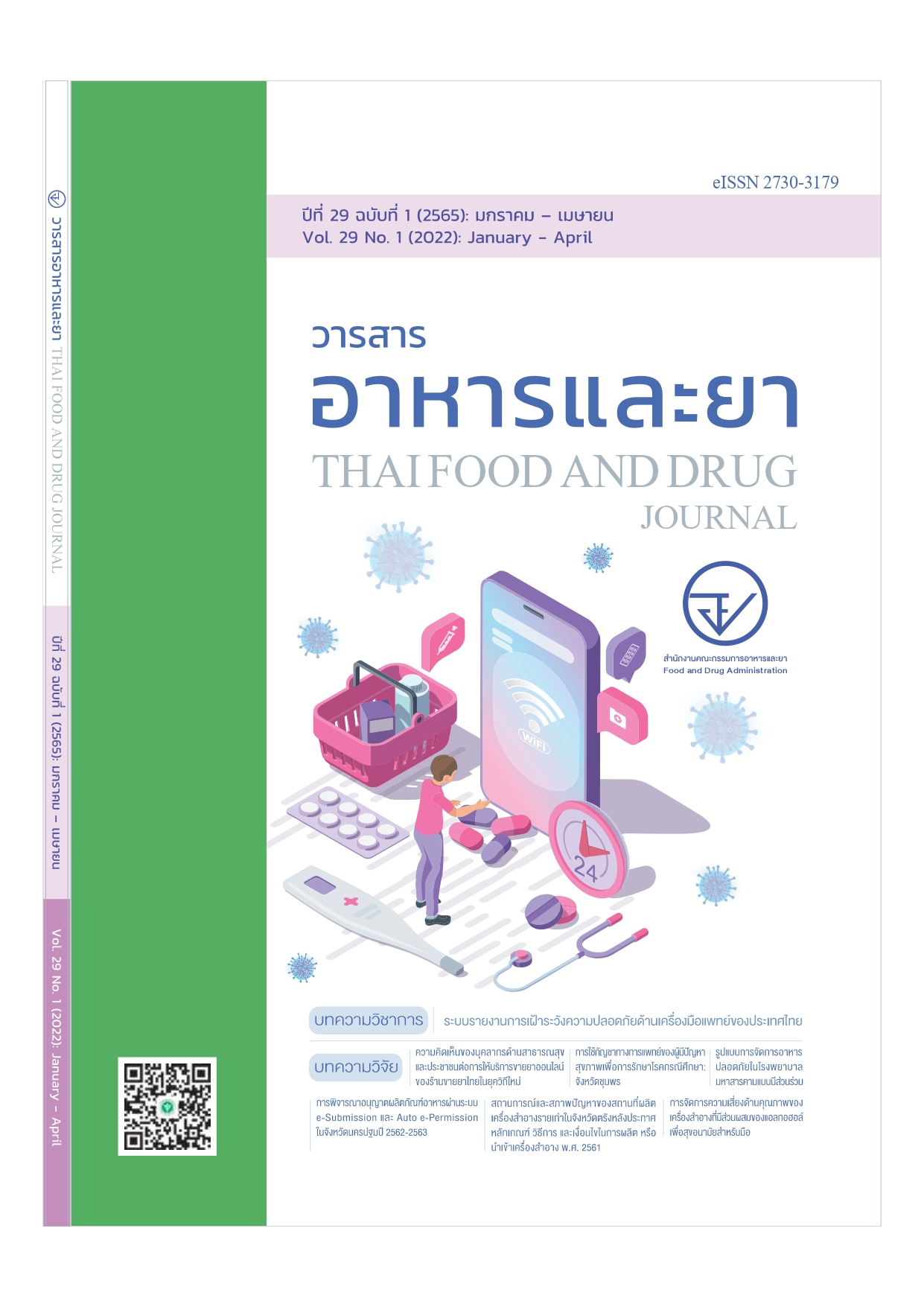การใช้กัญชาทางการแพทย์ของผู้มีปัญหาสุขภาพเพื่อการรักษาโรค: กรณีศึกษา จังหวัดชุมพร
Main Article Content
บทคัดย่อ
ความสำคัญ: ประเทศไทยเพิ่งให้มีการนำกัญชามาใช้ในทางการแพทย์โดยการแก้ไขกฎหมายพระราชบัญญัติยาเสพติดให้โทษ ฉบับที่ 7 มีผลบังคับใช้หลังประกาศในราชกิจจานุเบกษาเมื่อวันที่ 18 ก.พ. 2562 ให้สามารถนำกัญชาและพืชกระท่อมไปศึกษาวิจัยและพัฒนาเพื่อประโยชน์ทางการแพทย์และนำไปใช้ในการรักษาโรคภายใต้การดูแลและควบคุมของแพทย์ ซึ่งชุมพรเป็นจังหวัดหนึ่งที่มีการใช้กัญชาทางการแพทย์ในการรักษาบำบัดโรค
วัตถุประสงค์: เพื่อศึกษาการใช้กัญชาทางการแพทย์ของผู้มีปัญหาสุขภาพ และความสัมพันธ์ระหว่างช่วงอายุ อาชีพและประสบการณ์กับการใช้กัญชาของผู้มีปัญหาสุขภาพ
วิธีการศึกษา: เป็นการศึกษาเชิงพรรณนา โดยใช้แบบสอบถามกลุ่มเป้าหมายผู้ที่มีปัญหาสุขภาพที่ใช้กัญชาเพื่อการรักษาโรคของผู้ป่วยในจังหวัดชุมพร ใช้สุ่มตัวอย่างแบบตามสะดวกที่ระดับความเชื่อมั่นที่ 95% จากประชากร 796 คน โดยเก็บตัวอย่างได้ 266 ตัวอย่าง ใช้สถิติเป็นร้อยละ ค่าเฉลี่ย ส่วนเบี่ยงเบนมาตรฐาน และค่าสัมประสิทธิ์สหสัมพันธ์ของเพียรสัน
ผลการวิจัย: พบว่า การใช้กัญชาทางการแพทย์ของผู้มีปัญหาสุขภาพในจังหวัดชุมพรส่วนใหญ่เป็นเพศชาย ร้อยละ 78.94. อายุระหว่าง 26 - 40 ปี ร้อยละ 52.25 สถานภาพสมรส ร้อยละ 65.03 และมีระดับการศึกษามัธยม/ปวช. ร้อยละ 38.34 ประกอบอาชีพเกษตรกร ร้อยละ 42.10 กลุ่มตัวอย่างมีปัญหาทางร่างกาย ร้อยละ 87.96 ปัญหาทางจิตใจ ร้อยละ 12.04 ส่วนโรคและอาการ 3 อันดับแรกที่เจ็บป่วย ได้แก่ โรคมะเร็ง โรคภูมิแพ้ และโรคไมเกรน ตามลำดับ ในด้านประสบการณ์การใช้กัญชา พบว่า เหตุผลของการใช้กัญชาครั้งแรก คือ การรักษา ระยะเวลาที่ใช้กัญชา 1-5 ปี และบุคคลอื่นที่ใช้กัญชาที่พบเจอจากคนที่ทำงานเดียวกัน ร้อยละ 60.90, 36.84 และ 33.08 ตามลำดับ ประเด็นกฎระเบียบและการเข้าถึงกัญชาทางการแพทย์ พบว่ามีค่าเฉลี่ยโดยรวม 4.549 อยู่ในระดับมากที่สุด จากคะแนนเต็ม 5 หัวข้อที่มีค่าเฉลี่ยสูงสุดคือ การมีกฎหมายบังคับใช้กัญชาเพื่อการรักษาเป็นเรื่องเหมาะสม 4.643 รองลงมา คือ แพทย์แผนปัจจุบันสามารถสั่งผลิตภัณฑ์กัญชาเพื่อการรักษาได้ เฉลี่ย 4.630 และการเข้าถึงผลิตภัณฑ์กัญชาเพื่อการรักษาควรเปิดเสรีเหมือนผลิตภัณฑ์ยาอื่น ๆ เฉลี่ย 4.609 เมื่อศึกษาความสัมพันธ์ของตัวแปรช่วงอายุ อาชีพ และประสบการณ์การใช้กัญชา กับการใช้กัญชาของผู้มีปัญหาสุขภาพในจังหวัดชุมพร พบว่า มีความสัมพันธ์ทางบวกกับการใช้กัญชาของผู้มีปัญหาสุขภาพในระดับปานกลาง ดี ดีมาก ตามลำดับ อย่างมีนัยสำคัญทางสถิติที่ p-value น้อยกว่า 0.1 นอกจากนั้น พบปัญหาอุปสรรคสำคัญที่กลุ่มตัวอย่างให้ความคิดเห็นคือ การเข้าถึงเป็นความยากลำบากของผู้ป่วยที่จะหากัญชา เพราะจัดเป็นยาเสพติดที่ต้องควบคุมเพื่อความปลอดภัย
สรุป: ผู้ใช้กัญชาทางการแพทย์ที่ตอบแบบสำรวจส่วนใหญ่เป็นเกษตรกร โดยกลุ่มตัวอย่าง 3 ใน 4 มีปัญหาทางร่างกาย ซึ่งเหตุผลการใช้ครั้งแรกคือเพื่อการรักษา มีความเห็นต่อการบังคับใช้กฎหมายว่าเป็นเรื่องเหมาะสม แต่ควรเปิดให้ประชาชนเข้าถึงได้เสรีเช่นเดียวกับผลิตภัณฑ์ยา ส่วนช่วงอายุ อาชีพ และประสบการณ์การใช้กัญชาของผู้มีปัญหาสุขภาพมีความสัมพันธ์ทางบวกกับการใช้กัญชาทางการแพทย์อย่างมีนัยสำคัญทางสถิติ
Article Details

อนุญาตภายใต้เงื่อนไข Creative Commons Attribution 4.0 International License.
เอกสารอ้างอิง
1.ปัทมา พลอยสว่าง, วีรวุฒิ อิ่มสำราญ, ศุลีพร แสงกระจ่าง. กัญชา: ประโยชน์ทางการแพทย์และความเป็นพิษ. วารสารการแพทย์ไทยและการแพทย์ทางเลือก 2559;14(2):115-123.
2.สุนทร พุทธศรีจารุ. การพัฒนามาตรการทางกฎหมายควบคุมการใช้กัญชาทางการแพทย์และการนำไปสู่การปฏิบัติ. วารสารอาหารและยา 2562;26(2):10-19.
3.Yamane T. Statistics: an Introductory Analysis. 2nd Ed., New York: Harper and Row; 1967.
4.บุญชม ศรีสะอาด. การวิจัยเบื้องต้น (พิมพ์ครั้งที่ 7). กรุงเทพฯ: สุวีริยสาส์น; 2543.
5.บัณฑิต ศรไพศาล. คิดให้ชัดกับนโยบายกัญชาทางการแพทย์ของประเทศไทย. วารสารวิชาการสาธารณสุข 2562;28(4):755-766.
6.พีรพจน์ ปิ่นทองดี. กัญชา: กฎหมายยาเสพติดอันเป็นอุปสรรคต่อการพัฒนากัญชาการแพทย์. วารสารสันติศึกษาปริทรรศน์ มจร 2561;6(3):1182-1198.
7.วีรยา ถาอุปชิต, นุศราพร เกษสมบูรณ์. การใช้กัญชาทางการแพทย์. วารสารเภสัชศาสตร์อีสาน 2560;13(Supplement):228-240.
8.กรพินทุ์ ปานวิเชียร. ปัจจัยที่มีความสัมพันธ์กับระดับพฤติกรรมการใช้กัญชาเพื่อประโยชน์ทางการแพทย์.วารสารบรมราชชนนีสุพรรณบุรี 2563;3(1):31-42.
9.ชนิดา มัททวางกูร, ขวัญเรือน ก๋าตู, สุธิดา ดีหนู, สิริหนู สินวรรณกุล. ปัจจัยที่มีความสัมพันธ์กับพฤติกรรมการใช้สมุนไพรของประชาชนในเขตภาษีเจริญ. วารสารพยาบาลศาสตร์มหาวิทยาลัย 2562;20(39):99-109.


